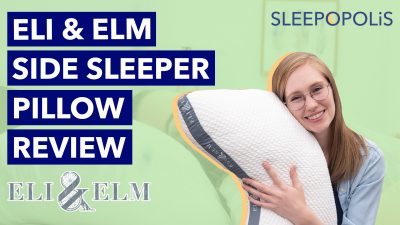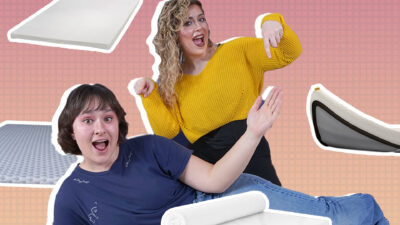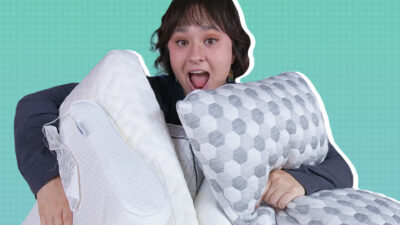According to the National Center for Biotechnology Information, over 60 percent of adults sleep on their side. So what kind of mattress should you get?
We think that the best mattress for side sleepers is going to offer plenty of pressure relief at the shoulders and hips, which is where these folks put the most pressure. At the same time, it needs to be supportive enough to prevent them from sinking too far into the bed and throwing their spine out of alignment.
Unfortunately, many mattresses aren’t built to meet the side sleeper’s specific needs. They’re either too firm (thereby inducing pressure at the shoulders and hips) or too soft (resulting in an overall lack of support). With that in mind, we recommend that side sleepers opt for either a medium-firm mattress or a soft to medium-soft mattress. Below, we’ll highlight some of our favorites that fall into this firmness range and dive into all the factors that contribute to a sound side-sleeping experience.
To pick these mattresses, our team of mattress review experts ran each one through a series of tests to see how well it performed in areas such as cooling, pain relief, motion isolation, and more. We paid special attention to pain relief, especially at the shoulders and hips. A good mattress for you isn’t going to put any added pressure on these areas.
Our Top Pick for Side Sleepers
The Helix Midnight landed at the top of our list for the best mattress for side sleepers due to its medium-firm feel and good balance of comfort and support. Side sleepers will appreciate the zoned support, which cushions the shoulders and hips while supporting the lower back.
Best Mattresses for Side Sleepers
- Helix Midnight – Best Overall Mattress for Side Sleepers
- Saatva – Best Mattress for Combination Side Sleepers
- Nectar – Best Memory Foam Mattress for Side Sleepers
- WinkBed – Best Cooling Mattress for Side Sleepers
- Brooklyn Bedding Aurora Luxe – Best Mattress for Side Sleepers with Hip Pain
- Titan Plus Luxe – Best Mattress for Heavy Side Sleepers
- Bear Star Hybrid – Best Mattress for Side Sleepers with Back Pain
- Nolah Evolution – Best Soft Mattress for Side Sleepers
Our Tests of the Best Mattress for Side Sleepers Video
Compare the Best Mattresses For Side Sleepers
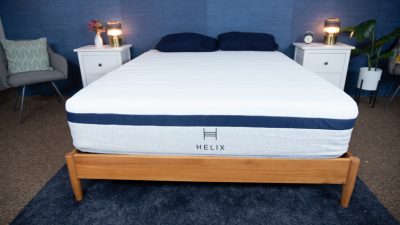
|
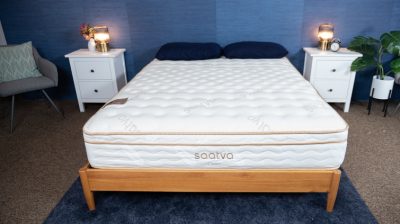
|
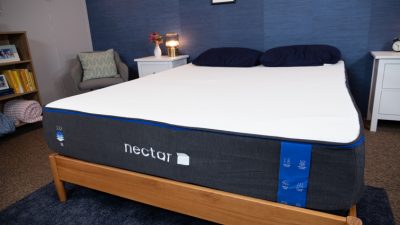
|
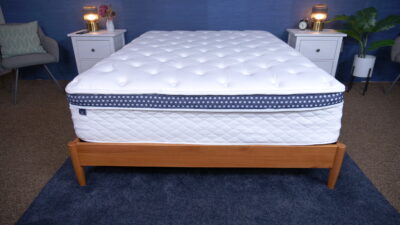
|
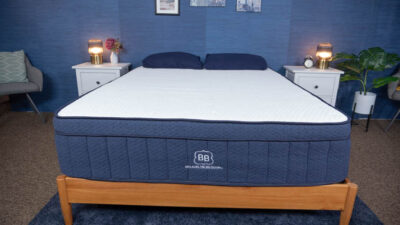
|
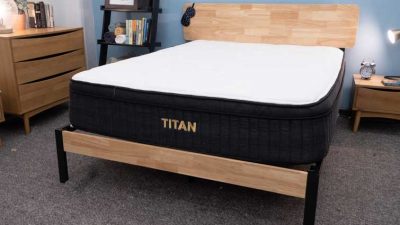
|
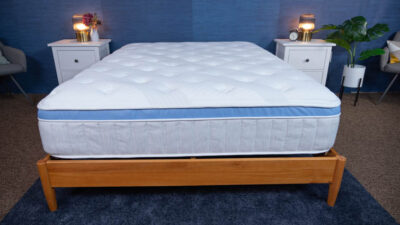
|
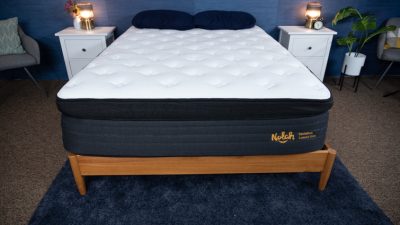
|
|
| Helix Midnight Mattress | Saatva Mattress | Nectar Mattress | WinkBed Mattress | Brooklyn Bedding Aurora Luxe Mattress | Brooklyn Bedding Titan Plus Luxe | Bear Star Hybrid Mattress | Nolah Evolution Hybrid Mattress | |
| Rating | ||||||||
| Firmness | Medium-firm: 6.5/10 | Multiple firmness options | Medium-soft: 6/10 | Multiple firmness options | Multiple firmness options | Medium-firm: 6.5/10 | Soft: 6/10 | Multiple firmness options |
| Material | Hybrid | Innerspring | Foam | Hybrid | Hybrid | Hybrid | Hybrid | Hybrid |
| Cooling | -- | ✓ | -- | ✓ | ✓ | -- | ✓ | -- |
| Sleep Position | Back & Side | Back & Stomach | Back & Side | Combination | Back & Side | Back & Side | Back & Side | Back & Side |
Helix Midnight – Best Overall Mattress for Side Sleepers
The Helix Midnight was designed with side sleepers in mind. It offers these sleepers the sinkage they need at the shoulders and hips to promote a neutral spinal alignment. We recommend this mattress for the following sleeper types: Financing options are available for this mattress. The Helix Midnight was designed with side sleepers in mind. It offers these sleepers the sinkage they need at the shoulders and hips to promote a neutral spinal alignment. We recommend this mattress for the following sleeper types: Financing options are available for this mattress. The Helix Midnight was designed with side sleepers in mind. It offers these sleepers the sinkage they need at the shoulders and hips to promote a neutral spinal alignment. We recommend this mattress for the following sleeper types: Financing options are available for this mattress.Helix Midnight Mattress

Material
Hybrid
Trial Period
100 nights
Shipping Method
Free shipping
Firmness
Medium-firm: 6.5/10
Warranty
10-year warranty
Price Range
$$$$$
Couples
This bed has great motion isolation so you will not feel your partner tossing and turning at night.
Back Sleeping
Ideal for lightweight and average weight back sleepers.
Side Sleeping
Ideal for lightweight and average weight side sleepers.
Financing Options
Helix Midnight Mattress

Material
Hybrid
Warranty
10-year warranty
Firmness
Medium-firm: 6.5/10
Shipping Method
Free shipping
Trial Period
100 nights
Price Range
$$$$$
Couples
This bed has great motion isolation so you will not feel your partner tossing and turning at night.
Back Sleeping
Ideal for lightweight and average weight back sleepers.
Side Sleeping
Ideal for lightweight and average weight side sleepers.
Financing Options

Helix Midnight Mattress
Material
Hybrid
Firmness
Medium-firm: 6.5/10
Trial Period
100 nights
Warranty
10-year warranty
Shipping Method
Free shipping
Price Range
$$$$$
Couples
This bed has great motion isolation so you will not feel your partner tossing and turning at night.
Back Sleeping
Ideal for lightweight and average weight back sleepers.
Side Sleeping
Ideal for lightweight and average weight side sleepers.
Financing Options
Expert Opinion
At Sleepopolis, we’ve found that side sleepers require a unique balance of cushioning for their shoulders and hips, plus support for the lower back. Helix provides both in its Midnight model, a bed designed for side sleepers. It has a comfort layer of memory foam (the cushioning) and another layer below of pocketed coils (the support). When we lie down on it, we get a slight lift that tells us this is a supportive mattress. And to test out its cushioning, we use a device called a pressure map. The way it works is simple: we roll out the map across the mattress, then lie down on in it in different positions. The map then uses thermal imaging to display how much pressure is being put on our bodies. When we laid on our sides, it showed very little pressure buildup at the shoulders and hips. As a side sleeper, this is what you want to see.
I honestly understand why this is the brand’s most popular model. It’s really comfortable and supportive for back and side sleeping. I love that the Helix Midnight offers solid edge support — you can use the whole bed!
Bridget Chapman, Senior Product Editor
What Customers Say
Online, customers have consistently recommended the Helix Midnight for its medium level of comfort and ease of ordering. The brand even has a sleep quiz on their website, which you can take for a tailored mattress recommendation. So if you’re still unsure whether or not the Midnight is the right bed for you, you can get some other suggestions. You can also test out the mattress in person at showrooms across the country operated by Helix’s brand partners. But the simplest and most convenient way to buy a Helix mattress is online.
Pros of the Helix Midnight Mattress
- For an extra charge, you can upgrade to the Helix Midnight Luxe, which comes with a soft pillow top and coils that offer zoned support. That means they’re firmer in certain spots of the mattress and softer in others.
- For hot sleepers, the Helix Midnight has several features to help regulate temperature, starting with a breathable cover of Tencel (a naturally cooling material sourced from eucalyptus) and ending with the coils, which have plenty of space for airflow.
- Couples should be comfortable on the Helix Midnight because of its cooling capabilities and strong edge support, which allows two bodies to spread out and use the whole surface of the bed.
Cons of the Helix Midnight Mattress
- We don’t recommend the Helix Midnight to average weight or heavy stomach sleepers. These folks need more support than back sleepers and side sleepers, and they’re not likely to get it here.
Click here to get our best deal on the Helix Midnight or view our full Helix Midnight mattress review. Or if you’re interested in some other options, you can check out our best mattresses page.
Saatva – Best Mattress for Combination Side Sleepers
The Saatva comes in three firmness options. The Plush Soft version of the Saatva is a good choice for combination side sleepers, as it will cradle their joints nicely while still making it easy to switch positions. We recommend this mattress for the following sleeper types: Financing options are available for this mattress. We were skeptical of buying a mattress on line but it could not have gone any smoother. Anthony answered all of our questions during our many phone conversations. Delivery was prompt and went without a hitch. Best of all the mattress is so comfortable! I haven't had such a good night sleep in years. Highly recommend this.
The Saatva comes in three firmness options. The Plush Soft version of the Saatva is a good choice for combination side sleepers, as it will cradle their joints nicely while still making it easy to switch positions. We recommend this mattress for the following sleeper types: Financing options are available for this mattress. We were skeptical of buying a mattress on line but it could not have gone any smoother. Anthony answered all of our questions during our many phone conversations. Delivery was prompt and went without a hitch. Best of all the mattress is so comfortable! I haven't had such a good night sleep in years. Highly recommend this.
The Saatva comes in three firmness options. The Plush Soft version of the Saatva is a good choice for combination side sleepers, as it will cradle their joints nicely while still making it easy to switch positions. We recommend this mattress for the following sleeper types: Financing options are available for this mattress. We were skeptical of buying a mattress on line but it could not have gone any smoother. Anthony answered all of our questions during our many phone conversations. Delivery was prompt and went without a hitch. Best of all the mattress is so comfortable! I haven't had such a good night sleep in years. Highly recommend this.
Saatva Mattress

Material
Innerspring
Trial Period
365 nights
Shipping Method
Free white glove delivery
Firmness
Multiple firmness options
Warranty
Lifetime warranty
Price Range
$$$$$
Hot Sleepers
If you often overheat while you sleep, this mattress should help you stay cool.
Back Pain
This bed is perfect for anyone suffering from back pain.
Back Sleeping
Ideal for lightweight, average weight, and heavyweight back sleepers.
Stomach Sleeping
Ideal for lightweight and average weight stomach sleepers.
Financing Options
Saatva Mattress

Material
Innerspring
Warranty
Lifetime warranty
Firmness
Multiple firmness options
Shipping Method
Free white glove delivery
Trial Period
365 nights
Price Range
$$$$$
Hot Sleepers
If you often overheat while you sleep, this mattress should help you stay cool.
Back Pain
This bed is perfect for anyone suffering from back pain.
Back Sleeping
Ideal for lightweight, average weight, and heavyweight back sleepers.
Stomach Sleeping
Ideal for lightweight and average weight stomach sleepers.
Financing Options

Saatva Mattress
Material
Innerspring
Firmness
Multiple firmness options
Trial Period
365 nights
Warranty
Lifetime warranty
Shipping Method
Free white glove delivery
Price Range
$$$$$
Hot Sleepers
If you often overheat while you sleep, this mattress should help you stay cool.
Back Pain
This bed is perfect for anyone suffering from back pain.
Back Sleeping
Ideal for lightweight, average weight, and heavyweight back sleepers.
Stomach Sleeping
Ideal for lightweight and average weight stomach sleepers.
Financing Options
Expert Opinion
If you switch between sleeping on your side and sleeping on your back or stomach, you’ll want a responsive mattress that makes it easy to change positions. We think you’ll find what you’re looking for in the Saatva, a luxury innerspring mattress with not one, but two layers of coils. These springs create a lot of bounce and responsiveness, and when we laid down on the bed and rolled around, we were able to shift sleeping positions without a problem. The bed is available in three different levels of firmness: Plush Soft, Luxury Firm, and Firm. Since side sleepers (even combination side sleepers) tend to need more softness at their shoulders and hips, we recommend they opt for the Plush Soft. Regardless of which model you choose, the mattress is capped with a Euro top that gives you a little bit of contouring — another plus for side sleepers.
Other folks who might enjoy the Saatva’s responsiveness are couples, as long as they’re not light sleepers (more on that in our Cons section below). The bed’s bounce makes it a good option for sex, as it allows partners to move around and switch positions. They should also appreciate the support of the springs, which should have no problem lifting up two bodies.
What our tester says: “I thought the Saatva was super easy to move around on thanks to its coil layers and cushiony foam top. I found the Luxury Firm model to have a very supportive, yet plush feel that kept me comfortable in multiple sleep positions.” – Bridget Chapman, senior product editor
What Customers Say
When seeing what customers had to say about the Saatva, we noticed many folks praising the support of the coils and the brand’s customer service. Saatva also offers free white glove delivery, meaning that they’ll send someone to not only deliver your new mattress, but set it up in your bedroom. And because the company’s mattresses are uncompressed and don’t come in a box, there’s no off-gassing period, and you can use it right away. But if you insist on wanting to first try out a Saatva in person, you can do so at their viewing rooms in New York, San Francisco, Boston, Chicago, and other major cities.
Pros of the Saatva Mattress
- The Saatva’s double layer of coils gives the bed strong edge support. This means you can sleep right against the edge of the mattress without feeling like you’re going to fall off.
- Because the Saatva is available in three different firmness levels, there’s a model for all sleeping positions. Back sleepers should be most comfortable on the Luxury Firm, and stomach sleepers should be most comfortable on the Firm.
- The Saatva sleeps cool, thanks to the high number of coils in its construction. Coils leave lots of space in the mattress, allowing air to flow freely throughout the bed.
Cons of the Saatva Mattress
- While the Saatva’s responsiveness makes it easy to switch positions, it also gives the bed high motion transfer. That means it’s easy for motion to ripple across the bed. If you share your mattress with a partner and either one of you are light sleepers, you may be woken up by each other’s tossing and turning.
Sold on the Saatva Classic? Get our best deal here or read our full Saatva mattress review. Check out our other top picks for the best mattress for combination sleepers if you’re still searching.
Nectar – Best Memory Foam Mattress for Side Sleepers
Side sleepers on a budget should take a look at the Nectar, a value memory foam mattress that provides lots of contouring. We recommend this mattress for the following sleeper types: Financing options are available for this mattress. I dreaded paying for a new mattress but my old one was 15 years old…buying a Nectar was the best choice I could have made! It is so comfortable and didn’t cost an arm and a leg. I would absolutely recommend this mattress to anyone!
Side sleepers on a budget should take a look at the Nectar, a value memory foam mattress that provides lots of contouring. We recommend this mattress for the following sleeper types: Financing options are available for this mattress. I dreaded paying for a new mattress but my old one was 15 years old…buying a Nectar was the best choice I could have made! It is so comfortable and didn’t cost an arm and a leg. I would absolutely recommend this mattress to anyone!
Side sleepers on a budget should take a look at the Nectar, a value memory foam mattress that provides lots of contouring. We recommend this mattress for the following sleeper types: Financing options are available for this mattress. I dreaded paying for a new mattress but my old one was 15 years old…buying a Nectar was the best choice I could have made! It is so comfortable and didn’t cost an arm and a leg. I would absolutely recommend this mattress to anyone!
Nectar Mattress

Material
Foam
Trial Period
365 nights
Shipping Method
Free shipping
Firmness
Medium-soft: 6/10
Warranty
Lifetime warranty
Price Range
$$$$$
Joint Pain
This bed is perfect for anyone suffering from joint pain.
Hip Pain
This bed is perfect for anyone suffering from hip pain.
Back Sleeping
Ideal for lightweight and average weight back sleepers.
Side Sleeping
Ideal for lightweight and average weight side sleepers.
Financing Options
Nectar Mattress

Material
Foam
Warranty
Lifetime warranty
Firmness
Medium-soft: 6/10
Shipping Method
Free shipping
Trial Period
365 nights
Price Range
$$$$$
Joint Pain
This bed is perfect for anyone suffering from joint pain.
Hip Pain
This bed is perfect for anyone suffering from hip pain.
Back Sleeping
Ideal for lightweight and average weight back sleepers.
Side Sleeping
Ideal for lightweight and average weight side sleepers.
Financing Options

Nectar Mattress
Material
Foam
Firmness
Medium-soft: 6/10
Trial Period
365 nights
Warranty
Lifetime warranty
Shipping Method
Free shipping
Price Range
$$$$$
Joint Pain
This bed is perfect for anyone suffering from joint pain.
Hip Pain
This bed is perfect for anyone suffering from hip pain.
Back Sleeping
Ideal for lightweight and average weight back sleepers.
Side Sleeping
Ideal for lightweight and average weight side sleepers.
Financing Options
Expert Opinion
We often recommend memory foam mattresses to side sleepers, as the material can provide a lot of softness and contouring at the shoulders and hips, where these folks put the most pressure. They should be extremely comfortable on the Nectar, which starts off with a thick top layer of memory foam to contour the body’s pressure points. When we laid our pressure map across the mattress’s surface, it showed little pressure at the shoulders and hips, telling us that the Nectar really is doing its job.
What our tester says: “If you love deep sinkage and contouring, this is the mattress for you. I especially like this feel for back and side sleepers, who should find their pressure points cushioned, and spines supported. The Nectar also has good motion isolation, so you shouldn’t feel your partner or pet moving around at night.” – Bridget Chapman, senior product editor
What Customers Say
On Amazon, several customers have commented positively on the Nectar’s value price (more on that below), as well as the foam’s ability to relieve pain in the joints. Some folks also found it to be more supportive than the typical memory foam mattress. If you want to test out a Nectar in person, they stock their mattresses in the showrooms of over 4,000 brand partners throughout the United States, including Mattress Firm and Bed Pros.
Pros of the Nectar Mattress
- Shoppers can often find a queen size Nectar for around or a little under $1,000, and this is all before considering the frequent discounts and sales the company has on its website. This makes the bed a quality budget mattress.
- The Nectar’s memory foam is CertiPUR-US Certified, meaning it has lower Volatile Organic Compound emissions and is safer for sleepers.
- Below the memory foam is a firmer layer of high-density base foam. This helps keep the spine in a neutral alignment and makes the Nectar comfortable for back sleepers.
Cons of the Nectar Mattress
- A downside of memory foam is that it tends to heat up. So if you’re a hot sleeper, you may not be comfortable on the Nectar.
- It can also be hard to change positions on memory foam mattresses. If you’re a combination sleeper who needs to move around at night, you may find it hard to do so on the Nectar.
Will Nectar give you the most bang for your buck? Get our best deal here or learn more in our full Nectar mattress review. Not sold on Nectar? Check out other best memory foam mattresses.
WinkBed Original – Best Cooling Mattress for Side Sleepers
Fans of the WinkBed love it for its pocketed coil support and Euro-Pillow top, which provide a nice, firm feeling. We recommend this mattress for the following sleeper types: Financing options are available for this mattress. Absolutely the greatest mattress I've ever slept on. It is soft yet firm in the right spots. Quality is on another level. You get what you pay for.
Fans of the WinkBed love it for its pocketed coil support and Euro-Pillow top, which provide a nice, firm feeling. We recommend this mattress for the following sleeper types: Financing options are available for this mattress. Absolutely the greatest mattress I've ever slept on. It is soft yet firm in the right spots. Quality is on another level. You get what you pay for.
Fans of the WinkBed love it for its pocketed coil support and Euro-Pillow top, which provide a nice, firm feeling. We recommend this mattress for the following sleeper types: Financing options are available for this mattress. Absolutely the greatest mattress I've ever slept on. It is soft yet firm in the right spots. Quality is on another level. You get what you pay for.
WinkBed Mattress

Material
Hybrid
Trial Period
120 nights
Shipping Method
Free shipping
Firmness
Multiple firmness options
Warranty
Lifetime warranty
Price Range
$$$$$
Hot Sleepers
If you often overheat while you sleep, this mattress should help you stay cool.
Back Pain
This bed is perfect for anyone suffering from back pain.
Back Sleeping
Ideal for lightweight and average weight back sleepers.
Side Sleeping
Ideal for lightweight and average weight side sleepers.
Stomach Sleeping
Ideal for average weight stomach sleepers.
Financing Options
WinkBed Mattress

Material
Hybrid
Warranty
Lifetime warranty
Firmness
Multiple firmness options
Shipping Method
Free shipping
Trial Period
120 nights
Price Range
$$$$$
Hot Sleepers
If you often overheat while you sleep, this mattress should help you stay cool.
Back Pain
This bed is perfect for anyone suffering from back pain.
Back Sleeping
Ideal for lightweight and average weight back sleepers.
Side Sleeping
Ideal for lightweight and average weight side sleepers.
Stomach Sleeping
Ideal for average weight stomach sleepers.
Financing Options

WinkBed Mattress
Material
Hybrid
Firmness
Multiple firmness options
Trial Period
120 nights
Warranty
Lifetime warranty
Shipping Method
Free shipping
Price Range
$$$$$
Hot Sleepers
If you often overheat while you sleep, this mattress should help you stay cool.
Back Pain
This bed is perfect for anyone suffering from back pain.
Back Sleeping
Ideal for lightweight and average weight back sleepers.
Side Sleeping
Ideal for lightweight and average weight side sleepers.
Stomach Sleeping
Ideal for average weight stomach sleepers.
Financing Options
Expert Opinion
If you’re a hot sleeper looking for a mattress to help cool you down, we’d like to steer you toward the WinkBed. It has a pocketed coil support layer that gives the mattress a traditional innerspring feel, but also plenty of room for airflow. To make things even cooler, there’s a cooling gel-infused Euro top. On the top layer of the mattress is a Tencel cover we found to be literally cool to the touch. The WinkBed should be great for a variety of sleepers, as it comes in several different models: Softer, Luxury Firm, and Firmer (we tested the Luxury Firm). However, we believe the Softer model to be best for most side sleepers, as it should provide the best pressure relief for the shoulder and hip. Side sleepers who weigh a bit heavier may do better on the more supportive Luxury Firm.
What our tester says: “Right when I interacted with the WinkBed, I could tell it was a high-quality mattress. It does a great job keeping you lifted up on top of the bed while still offering some cushioning around your joints. I really like how this bed comes in four firmness levels — I’d recommend side sleepers check out the Softer model.” – Bridget Chapman, senior product editor
What Customers Say
On WinkBed’s website, many reviewers have lauded the mattress’s firmness and support. Several of these folks have pointed out that it’s especially good for sleepers who suffer from sciatica and back pain. If you want to test out the mattress yourself, WinkBed doesn’t have any of its own brick and mortar stores, but they do stock their mattress in 14 different brand partner showrooms across the United States.
Pros of the WinkBed Mattress
- The WinkBed often lands on our roundup of the best mattresses for back pain.
- The mattress’s responsiveness makes it easy to get in and out of bed, which should be appealing to seniors and sleepers with mobility issues.
- You can also pay extra for the highly durable WinkBeds Plus, which was designed with heavy sleepers over 250 pounds in mind.
Cons of the WinkBed Mattress
- The WinkBed is priced higher than the average mattress, and might be too expensive for budget shoppers.
- Like many innerspring mattresses, the WinkBed has high motion transfer, so it might not be the best mattress for light-sleeping couples.
Think the WinkBed could be the right match for you? Get our best deal here or read our full WinkBed mattress review. Or you can look at some other options on our best cooling mattresses page.
Brooklyn Bedding Aurora Luxe – Best Mattress for Side Sleepers with Hip Pain
The Brooklyn Aurora Luxe comes in three firmness levels. The softest firmness level is best for side sleepers with hip pain, who need extra cushioning. We recommend this mattress for the following sleeper types: Financing options are available for this mattress. The Brooklyn Aurora Luxe comes in three firmness levels. The softest firmness level is best for side sleepers with hip pain, who need extra cushioning. We recommend this mattress for the following sleeper types: Financing options are available for this mattress. The Brooklyn Aurora Luxe comes in three firmness levels. The softest firmness level is best for side sleepers with hip pain, who need extra cushioning. We recommend this mattress for the following sleeper types: Financing options are available for this mattress.Brooklyn Bedding Aurora Luxe Mattress

Material
Hybrid
Trial Period
120 nights
Shipping Method
Free shipping
Firmness
Multiple firmness options
Warranty
10-year warranty
Price Range
$$$$$
Hot Sleepers
If you often overheat while you sleep, this mattress should help you stay cool.
Back Pain
This bed is perfect for anyone suffering from back pain.
Side Sleeping
Ideal for average weight side sleepers.
Financing Options
Brooklyn Bedding Aurora Luxe Mattress

Material
Hybrid
Warranty
10-year warranty
Firmness
Multiple firmness options
Shipping Method
Free shipping
Trial Period
120 nights
Price Range
$$$$$
Hot Sleepers
If you often overheat while you sleep, this mattress should help you stay cool.
Back Pain
This bed is perfect for anyone suffering from back pain.
Side Sleeping
Ideal for average weight side sleepers.
Financing Options

Brooklyn Bedding Aurora Luxe Mattress
Material
Hybrid
Firmness
Multiple firmness options
Trial Period
120 nights
Warranty
10-year warranty
Shipping Method
Free shipping
Price Range
$$$$$
Hot Sleepers
If you often overheat while you sleep, this mattress should help you stay cool.
Back Pain
This bed is perfect for anyone suffering from back pain.
Side Sleeping
Ideal for average weight side sleepers.
Financing Options
Expert Opinion
Because side sleepers put most of their weight on their hips and shoulders when they lie down, we’ve found that they may end up with hip pain if they don’t have a mattress that properly contours these areas. Brooklyn Bedding’s hybrid Aurora Luxe model tackles this issue head-on by offering three different firmness levels — Soft, Medium, and Firm, with the Soft catering to folks who sleep on their side. For visual proof, we rolled out our pressure map, which uses thermal imaging to display how much pressure a mattress is putting on the body. When we laid on our side on the Medium model, we saw some slight pressure buildup at the hips, but side sleepers should get all the pressure relief they need on the Soft model.
What our tester says: “I really loved the Aurora Luxe’s gentle, luxurious feel. The soft pillow top contours your hip and shoulder, providing great relief around those pressure spots. I felt really comfortable on the Medium mattress model on my side, but I think the Soft model could be even more soothing for sleepers with hip pain.” – Bridget Chapman, senior product editor
What Customers Say
With over 3,000 reviews on their website, Brooklyn Bedding clearly has a lot of vocal customers. And when it comes to the Aurora Luxe, they had plenty of good things to say, especially around the mattress’s cooling ability and easy delivery. Several folks said that this bed-in-a-box is tightly rolled when it’s brought to your door, making it easy to transport and unpack. That being said, you can also try it out yourself in one of Brooklyn Bedding’s physical store locations. These showrooms are scattered across the U.S. in many states, including California, Florida, and Arizona, where the company is headquartered.
Pros of the Brooklyn Bedding Aurora Luxe Mattress
- Hot sleepers, take note: the cover is made of a special Phase Change Material that helps folks sleep cool. The coils promote airflow, so the support layer helps you keep a low temperature.
- Back sleepers should also be comfortable on the Aurora Luxe, with the coils helping keep their spine neutrally aligned. We recommend that they choose the Medium model.
- Because the Aurora Luxe is responsive, cooling, and good at isolating motion, it should be an excellent choice for couples. However, we should point out that it doesn’t have the strongest edge support. If you sleep with a partner, you may want to opt for a king size so you have plenty of room to spread out.
Cons of the Brooklyn Bedding Aurora Luxe Mattress
- This mattress might not be supportive enough for heavier folks weighing over 250 pounds. Instead, check out the Titan Plus mattress, Brooklyn Bedding’s model made for heavy people.
- Unless they weigh less than 150 pounds, the Aurora Luxe likely won’t be able to keep stomach sleepers’ hips lifted throughout the night.
Sold on the Brooklyn Bedding Aurora mattress? Get our best deal here or read our full Brooklyn Bedding Aurora Luxe mattress review. Not sure it’s right for you? See more of the best mattresses for hip pain to find your perfect fit.
Titan Plus Luxe – Best Mattress for Heavy Side Sleepers
The Titan Luxe mattress is a hybrid mattress designed for heavy sleepers, like the firmer Titan mattress, but it is considerably softer.
The Titan Luxe mattress is a hybrid mattress designed for heavy sleepers, like the firmer Titan mattress, but it is considerably softer.
The Titan Luxe mattress is a hybrid mattress designed for heavy sleepers, like the firmer Titan mattress, but it is considerably softer.
Brooklyn Bedding Titan Plus Luxe

Material
Hybrid
Trial Period
120 nights
Shipping Method
Free shipping minus HI and AK
Firmness
Medium-firm: 6.5/10
Warranty
10-year warranty
Price Range
$$$$$
Brooklyn Bedding Titan Plus Luxe

Material
Hybrid
Warranty
10-year warranty
Firmness
Medium-firm: 6.5/10
Shipping Method
Free shipping minus HI and AK
Trial Period
120 nights
Price Range
$$$$$

Brooklyn Bedding Titan Plus Luxe
Material
Hybrid
Firmness
Medium-firm: 6.5/10
Trial Period
120 nights
Warranty
10-year warranty
Shipping Method
Free shipping minus HI and AK
Price Range
$$$$$
Expert Opinion
Brooklyn Bedding’s Titan Plus Luxe (the luxury upgrade of the standard Titan Plus) is designed for plus-size folks, including dedicated side sleepers. When first receiving the Titan Plus Luxe, we believed that these sleepers might enjoy the combination of support and pressure relief provided by such a sturdy bed. And to test this out, we brought in a heavier colleague, Paulie, to give the bed a try. He found the Titan Plus Luxe to be about 6.5 out of 10 on the firmness scale, giving him a balanced feel that hit the sweet spot between comfort and support. He felt lifted by the mattress’s extra-tall coils while also getting some cushioning from its quilted cover and multiple layers of foam. Average weight sleepers tend to experience a mattress as slightly firmer than heavy sleepers, so they may find the Titan Plus Luxe to be closer to a 7.5 on our mattress firmness scale.
What our tester says: “If you’re a heavy sleeper looking for a bed made of high-quality materials, the Titan Plus Luxe is a great option for you. It’s built to last and should do a great job supporting heavier sleepers, especially back, side, and combination sleepers.” – Madison Schaper, former Sleepopolis staff writer
What Customers Say
The Titan Plus Luxe has nearly 1,500 reviews on the brand’s website, with many heavy sleepers describing a similar experience as Paulie. Some of them also point out how cooling the mattress is, thanks to all the airflow promoted by the coils and an optional cooling top panel (note: you’ll have to pay extra for this). And while we think it’s easier (and cheaper) to buy a mattress online, you can check out the Titan Plus in person and one of Brooklyn Bedding’s many brick and mortar stores across the country.
Pros of the Titan Plus Luxe Mattress
- The Titan Plus Luxe has strong edge support that should increase its durability and prevent premature sagging.
- The mattress is fairly responsive, which should make it easy for heavy combination sleepers to switch positions at night.
- The Titan Plus Luxe had some of the lowest motion transfer results we’ve seen in our testing. No matter how much couples may toss and turn or how restless a sleeper they are, each partner should be able to sleep undisturbed.
Cons of the Titan Plus Luxe Mattress
- Since it was built for heavy sleepers, the Titan Plus Luxe is probably going to feel too firm for lightweight sleepers, and average weight sleepers who prefer a softer mattress.
Ready to check it out yourself? Get our best deal on the Titan Plus Luxe or read our full Titan Plus Luxe mattress review. You can also check out our roundup of the best mattresses for heavy people for more options.
Bear Star Hybrid – Best Mattress for Side Sleepers with Back Pain
The Bear Star Hybrid was designed with athletes in mind, so it’s no surprise it provides great support, excellent contouring, and pressure relief. We recommend this mattress for the following sleeper types: Financing options are available for this mattress. The Bear Star Hybrid was designed with athletes in mind, so it’s no surprise it provides great support, excellent contouring, and pressure relief. We recommend this mattress for the following sleeper types: Financing options are available for this mattress. The Bear Star Hybrid was designed with athletes in mind, so it’s no surprise it provides great support, excellent contouring, and pressure relief. We recommend this mattress for the following sleeper types: Financing options are available for this mattress.Bear Star Hybrid Mattress

Material
Hybrid
Trial Period
120 nights
Shipping Method
Free shipping
Firmness
Soft: 6/10
Warranty
Lifetime warranty
Price Range
$$$$$
Hot Sleepers
If you often overheat while you sleep, this mattress should help you stay cool.
Joint Pain
This bed is perfect for anyone suffering from joint pain.
Back Sleeping
Ideal for lightweight back sleepers.
Side Sleeping
Ideal for average weight side sleepers.
Financing Options
Bear Star Hybrid Mattress

Material
Hybrid
Warranty
Lifetime warranty
Firmness
Soft: 6/10
Shipping Method
Free shipping
Trial Period
120 nights
Price Range
$$$$$
Hot Sleepers
If you often overheat while you sleep, this mattress should help you stay cool.
Joint Pain
This bed is perfect for anyone suffering from joint pain.
Back Sleeping
Ideal for lightweight back sleepers.
Side Sleeping
Ideal for average weight side sleepers.
Financing Options

Bear Star Hybrid Mattress
Material
Hybrid
Firmness
Soft: 6/10
Trial Period
120 nights
Warranty
Lifetime warranty
Shipping Method
Free shipping
Price Range
$$$$$
Hot Sleepers
If you often overheat while you sleep, this mattress should help you stay cool.
Joint Pain
This bed is perfect for anyone suffering from joint pain.
Back Sleeping
Ideal for lightweight back sleepers.
Side Sleeping
Ideal for average weight side sleepers.
Financing Options
Expert Opinion
The Bear Star Hybrid was designed with athletes in mind, so it’s no surprise that it provides great support and pressure relief — both of which can help prevent back pain. In fact, when we rolled our pressure map across the mattress’s surface to see how much tension there was on our back, the map showed little to no pressure at all. This tells us that the Bear Star Hybrid’s mixture of copper-infused memory foam and individually wrapped coils should work together to keep the spine in a neutral alignment. Whether you’re an athlete or not, this isn’t a bed that’s going to worsen your aches and pains while side sleeping.
What our tester says: “I liked the Bear Star’s medium-soft, supportive feel. I felt nicely cushioned while side sleeping, but I could also easily switch into other positions and find comfort. The cushy foam layers and supportive coils helped promote spinal alignment and pressure relief, which is key for alleviating and preventing back pain.” – Bridget Chapman, senior product editor
What Customers Say
Several customers on Bear’s website have remarked how the Celliant cover has a somewhat luxurious feel to it, similar to what you’d find on a high-end hotel mattress. They also commented on the bed’s edge-to-edge coils, which — per the name — give the Bear Star Hybrid strong edge support. As for trying out a Bear mattress in person, you can do so at select stores of their brand partners, including Brooklyn Bedding. But we think it’s easiest to purchase a new mattress online.
Pros of the Bear Star Hybrid Mattress
- We scored the Bear Star Hybrid a 6 out of 10 on our firmness scale, meaning it’s a medium-soft mattress. For context, the industry standard for medium firm is 6.5 out of 10.
- Like many of Bear’s mattresses, the Star Hybrid has a cover made of Celliant, a material that some studies show can assist with blood flow and muscle recovery. This is part of why Bear is so popular amongst athletes. However, we should note that we haven’t formally tested Celliant’s recovery properties ourselves.
- Another perk of Celliant is that it sleeps cool. This, partnered with the copper infusion in the foam and the airflow-promoting coils, should help the Bear Star Hybrid sleep cool.
Cons of the Bear Star Hybrid Mattress
- Stomach sleepers are probably going to find the Bear Star Hybrid to be too soft to properly support them.
- Even with the layer of pocketed coils, the Bear Star Hybrid may not be supportive enough for heavier people over 250 pounds.
Ready to hibernate on the Bear? Get our best deal here or read our full Bear Star Hybrid mattress review. You can also see our page of the best mattresses for back pain for more options.
Nolah Evolution – Best Soft Mattress for Side Sleepers
The Nolah Evolution provides the contouring and cushioning that side sleepers need. It also absorbs motion very well, which is great news for couples looking to sleep soundly. We recommend this mattress for the following sleeper types: Financing options are available for this mattress. An amazing mattress! Constructed with luxuriously well made materials that are breathable and incredibly comfortable. After almost one year of sleeping on this mattress, my husband and I are still talking about how much we love it. We both are combo sleepers and feel it's the perfect balance between soft and firm. Plus, no more waking up with a sore back or tight neck. Would highly recommend!!
The Nolah Evolution provides the contouring and cushioning that side sleepers need. It also absorbs motion very well, which is great news for couples looking to sleep soundly. We recommend this mattress for the following sleeper types: Financing options are available for this mattress. An amazing mattress! Constructed with luxuriously well made materials that are breathable and incredibly comfortable. After almost one year of sleeping on this mattress, my husband and I are still talking about how much we love it. We both are combo sleepers and feel it's the perfect balance between soft and firm. Plus, no more waking up with a sore back or tight neck. Would highly recommend!!
The Nolah Evolution provides the contouring and cushioning that side sleepers need. It also absorbs motion very well, which is great news for couples looking to sleep soundly. We recommend this mattress for the following sleeper types: Financing options are available for this mattress. An amazing mattress! Constructed with luxuriously well made materials that are breathable and incredibly comfortable. After almost one year of sleeping on this mattress, my husband and I are still talking about how much we love it. We both are combo sleepers and feel it's the perfect balance between soft and firm. Plus, no more waking up with a sore back or tight neck. Would highly recommend!!
Nolah Evolution Hybrid Mattress

Material
Hybrid
Trial Period
120 nights
Shipping Method
Free shipping
Firmness
Multiple firmness options
Warranty
Lifetime warranty
Price Range
$$$$$
Back Sleeping
Ideal for lightweight and average weight back sleepers.
Side Sleeping
Ideal for lightweight and average weight side sleepers.
Financing Options
Nolah Evolution Hybrid Mattress

Material
Hybrid
Warranty
Lifetime warranty
Firmness
Multiple firmness options
Shipping Method
Free shipping
Trial Period
120 nights
Price Range
$$$$$
Back Sleeping
Ideal for lightweight and average weight back sleepers.
Side Sleeping
Ideal for lightweight and average weight side sleepers.
Financing Options

Nolah Evolution Hybrid Mattress
Material
Hybrid
Firmness
Multiple firmness options
Trial Period
120 nights
Warranty
Lifetime warranty
Shipping Method
Free shipping
Price Range
$$$$$
Back Sleeping
Ideal for lightweight and average weight back sleepers.
Side Sleeping
Ideal for lightweight and average weight side sleepers.
Financing Options
Expert Opinion
Sleepers wanting a soft mattress with a slow-sinking feeling should try out the Nolah Evolution. It has several layers of cushiony foam to cradle pressure points at the shoulders, hips, and knees. These are areas of the body where side sleepers need the most pressure relief. Below that, a layer of patented HDMax Eco Support Coils creates additional relief, as well as support. But don’t just take our word for it. As with all of our mattresses, we wanted to see how the Evolution performed under our trusty pressure map. Fortunately, when we laid on our side, the thermal imaging showed very little pressure at the shoulders and hips, confirming that it’s a fantastic fit for side sleepers.
What our tester says: “The Nolah Evolution reminded me of a mattress you’d find in a 5-star hotel. I found the Luxury Firm model to be comfy and pressure-relieving while side sleeping, but I think strict side sleepers may want to opt for the Plush model for even deeper contouring.” – Bridget Chapman, senior product editor
What Customers Say
In their online reviews, several people have singled out the Nolah Evolution’s pressure-relieving abilities. One customer even described how their husband struggles with chronic hip and shoulder pain, but felt very comfortable on the Evolution after about three weeks. Customers wanting to try out the mattress themselves can do so at a handful of showrooms from Nolah’s brand partners, including the Online Mattress Showroom in Minneapolis.
Pros of the Nolah Evolution Mattress
- The Nolah Evolution has a soft pillow top that feels like sinking into a luxurious, plush cloud. It may also alleviate hip or shoulder pain.
- The bed has strong edge support, meaning sleepers should feel comfortable sleeping near the end of the mattress.
- The Nolah Evolution’s foams are adept at absorbing motion, so couples are unlikely to feel each other tossing and turning. They should also appreciate the impressive edge support.
Cons of the Nolah Evolution Mattress
- The Nolah Evolution comes with a luxury price tag and may not be within everyone’s budget.
Does the Nolah sound like the mattress of your dreams? Get our best deal here or read our full Nolah Evolution mattress review. Need to do some more searching? Check out our roundup of the best soft mattresses.
Other Mattresses for Side Sleepers We Love
- Serta Perfect Sleeper Mattress: We like this bed for side sleepers its cushioning memory foam comfort layer eases joint pain for all body types, but it also boasts sufficient midsection support with sturdy individually wrapped coils. While it’s a pressure-relieving option that should appeal to most back and side sleepers, it isn’t a memory foam mattress, so those looking for a traditional sinking feel may not love this mattress. Read our full review.
- Casper Nova Hybrid Mattress: During testing, we found this mattress had stellar pressure relief results for side sleepers on sensitive areas like the hips and shoulders. Since this mattress is focused on a softer feel, we don’t feel this mattress has enough firmness and support for heavier sleepers (250 pounds or more). Read our full review.
- Purple Mattress: Due to this bed’s stretchy and breathable polymer grid, we found it provides just enough sinkage at the hips, shoulders, and knees to take pressure off of the joints. While it offers impressive relief for light and average-weight sleepers, those falling on the heavier side likely won’t receive the same amount of support. Read our full review.
- Sweenight Prime Mattress: If you’re an average-weight or heavyweight side sleeper, this mattress should be more than comfortable for you. It does lie on the firmer side, so while this should result in good lift and alignment for some, lightweight sleepers those who want a plusher feel will want a softer mattress. Read our full review.
What to Look for In a Mattress for Side Sleepers
After reading through our picks, you might be wondering: How did Sleepopolis really land on these mattresses as the best of the best for side sleepers? It’s a great question and one we’re happy to answer.
First, we’ll start with a few features side sleepers should make sure they look for in a mattress. Next, we’ll share which firmness is best, what mattress types are ideal for side sleepers, and some mattress accessories that side sleepers might want to add to their beds.
Side Sleeper Support
While support is an important factor for all sleepers to consider, it’s perhaps especially so for side sleepers, who tend toward nighttime contortions that aren’t necessarily conducive to healthy spine alignment (think fetal position). A mattress with fantastic support will adapt to the body no matter the shape, bringing the “musculoskeletal chain,” as Dr. Poorbaugh describes it, into a comfortable synergy.
What We Mean By “Support”
It’s important to note that support is not the same thing as firmness: A softer mattress can still provide great support. When looking for a new mattress that will meet your side sleeper needs, you’ll want to:
- Look for one that contours to your body’s unique shape.
- Find a bed that supports your hips and shoulders as you move and change sleep positions.
- Choose a mattress that alleviates tension across all parts of your body without leaving you feeling “swallowed” by the structure.
Firmness
Side sleepers are usually most comfortable on a soft to medium-firm mattress. Although they need some density and support, it’s important that there’s enough plushness in the bed’s construction to contour their shoulders and hips. We recommend that they don’t go firmer than a 6.5 out of 10 on our mattress firmness scale.
For context, the mattresses on this list range from 5.5 to 6.5, or come in several different firmness options, including a soft model.
Contouring
Similar to support, contouring is especially important for side sleepers. When you sleep on your side, you’re creating uneven space between your hips and shoulders. Rather than leaving this space unsupported, you’ll want a mattress that’s going to fill it in. That’s where contouring comes in. A mattress with good contouring will give you a little boost of support where you need it and will help you feel as if the mattress is cradling you rather than pushing up against your hips and shoulders.
Memory foam mattresses are particularly good at contouring – memory foam has a slow response to pressure and is known for adapting to your body’s unique shape.
Pressure Relief and Pain Relief for Side Sleepers
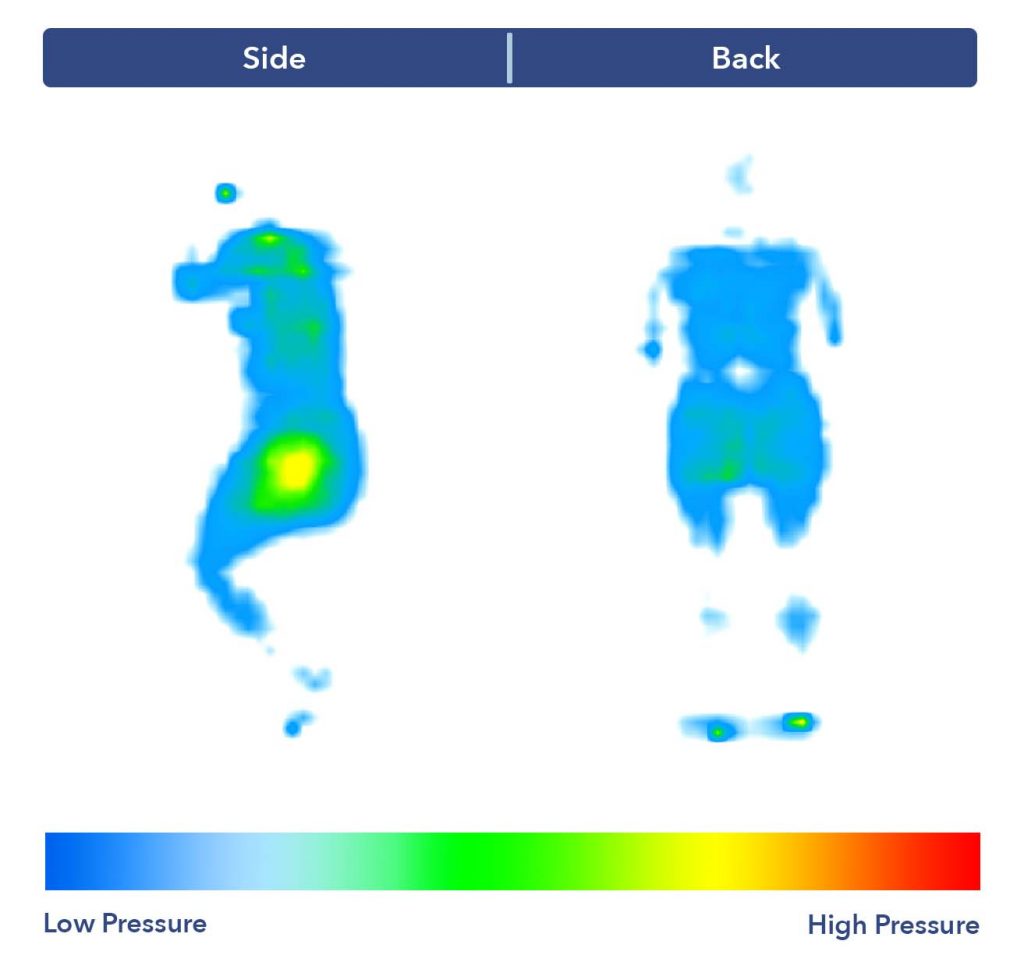
When you sleep on your side, you’re putting more pressure on your hips and shoulders than you would by resting on your back or stomach. This added pressure is fine, as long as you have the right mattress. You’ll want a mattress that’s going to both support you and relieve pressure at your hips and shoulders, which should help prevent pain from developing or worsening if you already have it.
The best mattresses for pressure relief are soft mattresses. These mattresses are especially good for side sleepers because they have the give necessary to allow hips and shoulders to really sink in.
Shoulder Pain
The best mattress for side sleepers with shoulder pain is going to be one that’s decidedly soft — a 5.5 out of 10 on the firmness scale or lower. If you’re like most side sleepers, you probably put more weight on your shoulders, and if you have pain in that area, you’re going to want a mattress that cushions it as much as possible.
Hip Pain
Similar to shoulder pain, if you experience hip pain, you’re likely also going to want a plush mattress that will cradle your sensitive joints. Again, a mattress that’s a 5.5 out of 10 or lower on the firmness scale is going to be best here.
Back Pain
If you’re a side sleeper who suffers from back pain, your main focus should be finding a bed that helps you achieve a neutral spine alignment. Keeping your spine in a straight line is key to preventing and alleviating pain, since straight is the spine’s natural position. The right mattress for you is going to be one that allows your hips and shoulders to sink at a level that helps you achieve that ideal neutral spinal alignment. We’d recommend seeing if a mattress has zoned support.
What the Heck Is Zoned Support?
Glad you asked! Basically, the term means that the mattress has different firmness levels (or zones, if you will) built into it to support all the different areas of your body.
For example, your shoulders tend to need a different amount of support than your back, so a mattress with zoned support might include a softer firmness level around your shoulders and a firmer one around your lower back.
Materials
When it comes to the best mattress materials for side sleepers, it depends on preference. They’ll definitely want a layer of foam that can offer contouring at the shoulders and hips, but the level of pressure relief varies depending on the foam’s source. For instance, memory foam is soft and has a very slow response to pressure, resulting in a hug-like feel. Latex foam can also be pressure relieving, but is bouncier and has a faster response to pressure, resulting in more of an “on top of” feel.
Regardless of what kind of foam is in their mattress, side sleepers will also want some kind of support core. This can come from a denser poly foam at the bottom of the mattress, or a layer of coils if it’s a hybrid mattress. Read more on the different types of mattresses below.
Price/Budget
A high-quality mattress for side sleepers is usually going to be between around $1,000 to $2,500 for a queen size (this is before any promotions or discounts). For context, the mattresses on this list range from $1,043 to $2,849 at the time of this writing (the higher end comes from a couple luxury mattresses). However, there are several budget options out there that could be a good fit. See the below lists for some of the most affordable mattresses.
How We Test the Best Mattresses for Side Sleepers
Here at Sleepopolis, we test each and every mattress in all three sleeping positions: back, side, and stomach. This first part of our process isn’t exactly rocket science; if you feel comfortable while lying on your side, chances are that the mattress is a good fit for side sleepers. But we also go beyond that initial step, running each bed through a battery of tests for a more scientific conclusion of who the mattress might be the best match for. In the case of side sleepers, we pay special attention to something called a pressure map.
A pressure map is a pad that we roll across the surface of a mattress. We lie down on it in different positions, and then it uses heat-mapping technology to visually display how much pressure is building up on various parts of our body. Blue indicates low pressure, green indicates moderate pressure, and yellow, orange, and red indicate high pressure. See the below results from the Helix Midnight for an example (this image also includes back sleeping).
Because side sleepers put the most weight on their shoulders and hips while lying down, we want to see little to no pressure in these areas. So if the pressure map displays blue or green at the shoulders and hips while our tester is side sleeping — like it does on the Helix Midnight above — the bed is going to be a good fit for this position.
One caveat: the tiny spot of yellow suggests a small amount of pressure, which might be felt by anyone who struggles with hip pain. That’s the beauty of the pressure map; it allows us to make hyper-specific recommendations. In this case, we recommend the Helix Midnight for side sleepers in general, but not if they tend to experience hip pain.
What is the Best Mattress Firmness for Side Sleepers?
In terms of firmness, side sleepers will want to look for something soft to moderate on the firmness scale. While many folks assume firmer mattresses are the most supportive, a special exception needs to be made for those who spend most of their slumber time on their sides.
“A firm mattress gives better support for pushing yourself up to a seated position,” Poorbaugh explains. “However, if you need pressure relief [as most side sleepers do], a plush mattress will have more cushion for those sensitive areas.“
So what exactly constitutes a plush mattress? In our opinion, a plush mattress:
- Comes in at a 4.5–6 out of 10 on the firmness scale (with 6.5 being medium firmness).
- Provides ample pressure relief and support to the neck, hips, and shoulders.
- Allows for deep sinkage to buffer against the formation of pressure points along the spine.
Firmness is perhaps the most important attribute for side sleepers due to the very nature of the position. (1) In order to provide proper support, the mattress must be able to contour to the curves of the body so the sleeper’s not “digging” into the structure.
What is the Best Type of Mattress for Side Sleepers?
We could make the argument for any type of mattress to be the best type for side sleepers, it really all depends on the sleeper’s body type, body weight, special concerns / preferences and what they really need out of a mattress.
Memory Foam Mattresses
Memory foam mattresses can be a good option for side sleepers because it cradles the areas that can sometimes feel “jammed” into a mattress. Memory foam is the best material for contouring to the body (think filling in where your body naturally lifts and sinking where your body applies more pressure), which can be great for people who have certain pain concerns and are looking for some relief. That being said, the material can get tricky for side sleepers if the bottom layer of foam is too soft that there’s nothing to stop the body from sinking all the way into the bed frame. This is usually a more common problem for heavier side sleepers.
Hybrid Mattresses
Hybrid mattresses are one of the most universal options for most sleeping positions, and side-sleeping is no different. A hybrid mattress is a combination of a coil base with either a foam or latex layer(s) on top. This construction results in a mattress that can be very supportive, but also has that cushioning, cradling feeling that a lot of side sleepers look for. Memory foam hybrid mattresses are also a great option for couples because the coils make them easy to move around on. while the foam absorbs a lot of the movement. The coils also allow for additional airflow, making these mattresses more breathable than solid memory foam beds.
Latex Mattresses
Most latex mattresses on the market are technically “latex hybrids,” meaning they have a coil base with a layer of latex on top. Latex beds are known for their bouncy surface and their tendency to be more naturally sourced. If you’re a strict side sleeper, you’ll want to make sure the supportive latex has enough give for your hips and shoulders. Latex mattresses are also a good option for combination sleepers who move between being back sleepers, side sleepers, and stomach sleepers all in one night.
Innerspring Mattresses
Innerspring mattresses are the most traditional type of mattress. The majority of their materials are made of innerspring coils, which are typically constructed from steel. These coils give the mattress a bouncy feel and provide plenty of responsiveness (think the opposite of memory foam). However, side sleepers beware — these mattresses tend to be on the firmer side. If you’re a fan of that classic innerspring feel and sleep on your side, I’d check to make sure the mattress is going to be soft enough to prevent jamming at your shoulders and undue pressure at your hips.
Mattress Accessories for Side Sleepers
Pillows
Good pillows are just as important as a good mattress. You may have an exceptionally well-made and comfortable mattress, but without a good pillow, you may still find that your sleeping experience is less than ideal.
A high-quality pillow is critically important for side sleepers due to their increased — and somewhat more complex — support needs. (3) Pillows made from latex, shredded foam, memory foam, or other poly foams can help provide consistent and stable support by responding to the varying pressures of your head and neck. Additionally, you’ll want to look for a pillow that is tall enough to cradle your head and neck but not so tall that you introduce a new form of pressure.
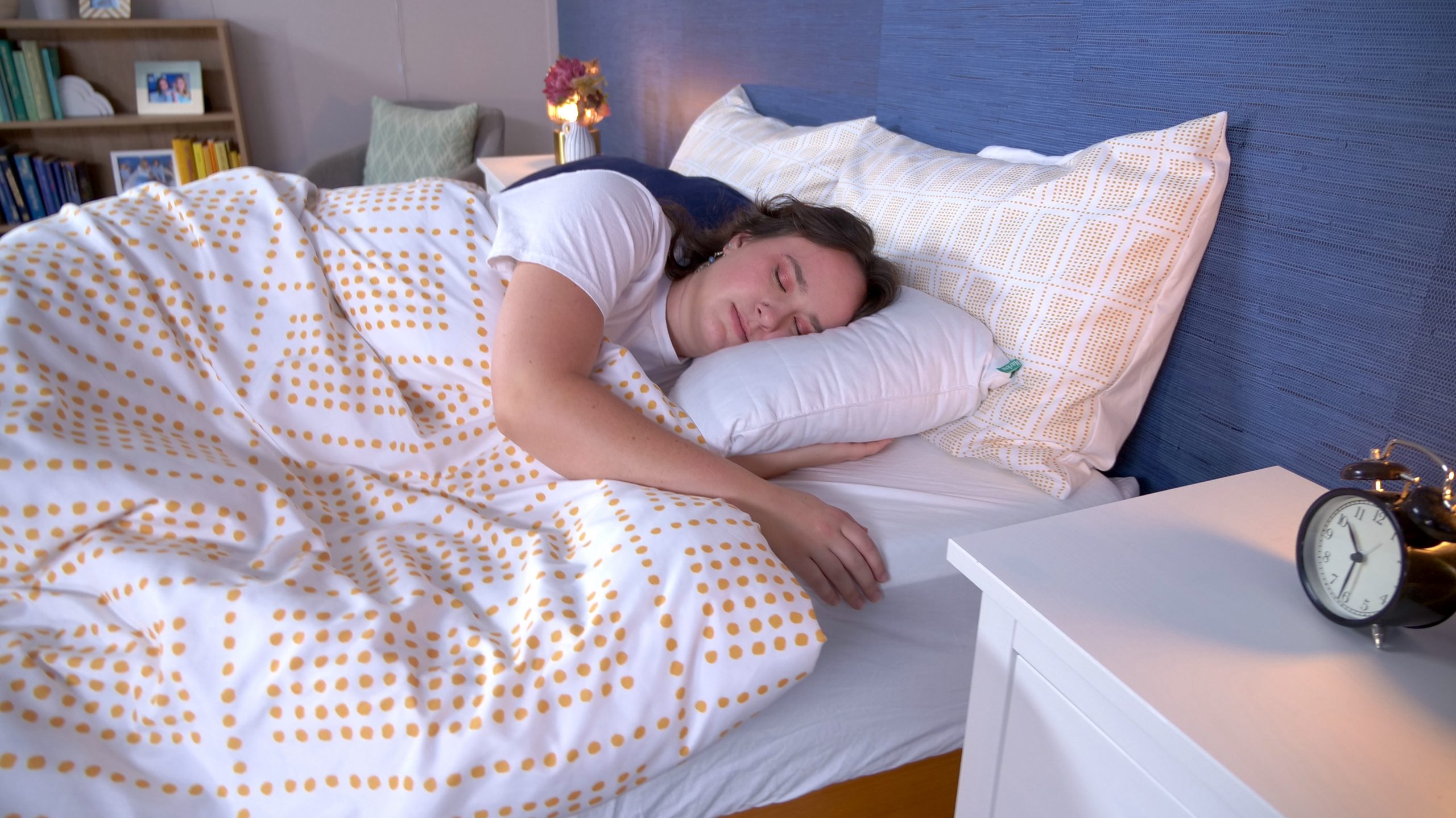
“Improved [spinal] alignment… can be easily achieved inside lying with proper pillow positioning,” explains Dr. Poorbaugh.
“Pillow placement at the head and neck can reduce an irritating kink in the neck, while a pillow between the knees should help keep the lumbar spine in neutral alignment.”
Keith Poorbaugh, licensed physical therapist
For more, check out our breakdown of the absolute best pillows for side sleepers.
Mattress Toppers
Mattress toppers can be a great way for side sleepers to add some plushness to their mattress. If your mattress is slightly firmer than you’d like, a quality mattress topper can create a softer overall feel, helping you achieve that perfect side sleeper firmness.
We’d recommend going for a taller-profile mattress topper if you’re a side sleeper. A mattress topper of at least three inches will allow lots of room for you to sink into the material, providing cushioning around the shoulder and hip for needed pressure relief. One of our best plush mattress toppers is a good place to start — or take a look at our best mattress toppers for side sleepers.
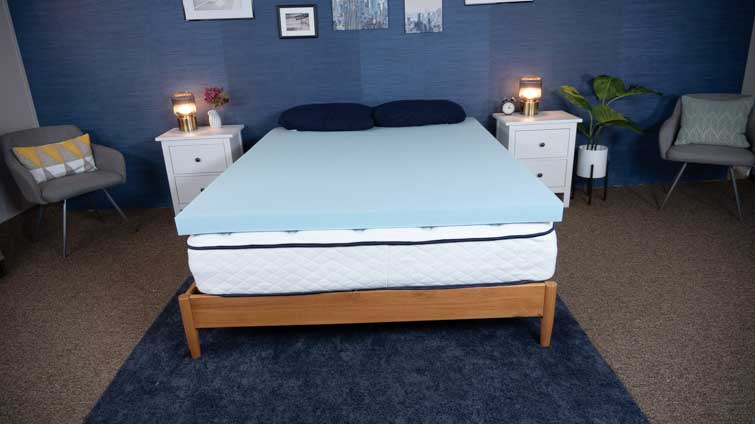
We also particularly like memory foam mattress toppers for side sleepers. This is because memory foam toppers are typically made to provide more pressure relief, and tend to have a soft, squishy feel. Memory foam is a great material for those who doze on their sides because it offers plenty of contouring, which helps cradle side sleepers’ shoulders and hips and fill in the space between.
Check out our best mattress topper roundup for even more options.
A Look Into the Sleepopolis Testing Lab
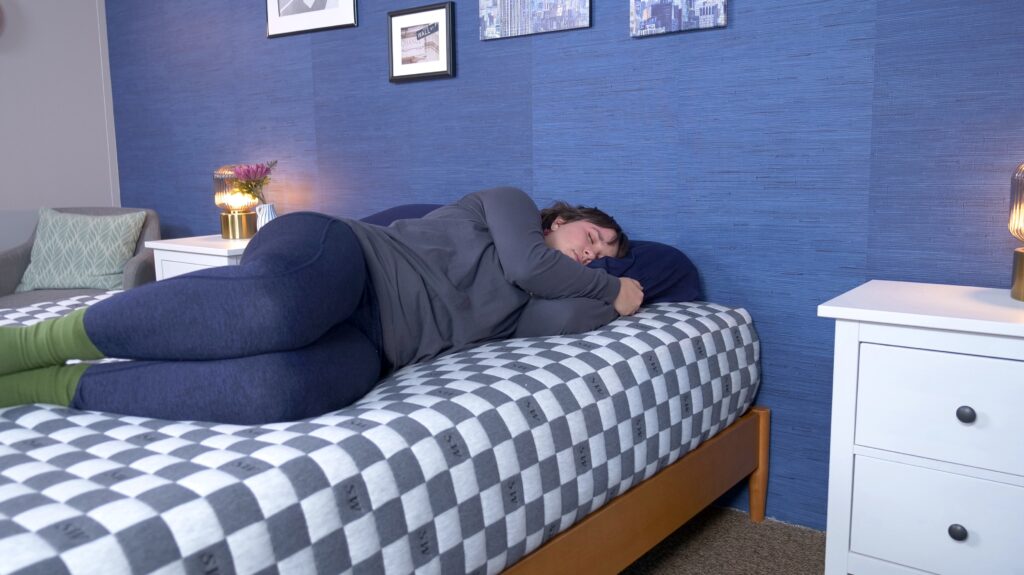
In order to ensure that we’re recommending the best mattresses to sleepers everywhere, we test each one individually in our mattress lab in Raleigh, North Carolina. Here, our team of Certified Sleep Science Coaches has reviewed more than 300 beds, putting each one through a rigorous testing process that includes measuring a mattress’s motion transfer with a seismometer, tracking its cooling capabilities with a thermal gun, and visualizing its ability to relieve pain with a pressure map.
From there, we give every bed an overall score based on its materials, comfort, support, cooling, edge support, and more. We also factor in brand performance with categories such as value and warranty.
We know that sleep is an integral part of your health, which is why we’ve developed such a detailed methodology when testing mattresses and writing our reviews. We also know that every sleeper is different when it comes to body type, sleeping position, and mattress preference. With so many factors at play, we want to give you an informed opinion so you can make an informed purchase.
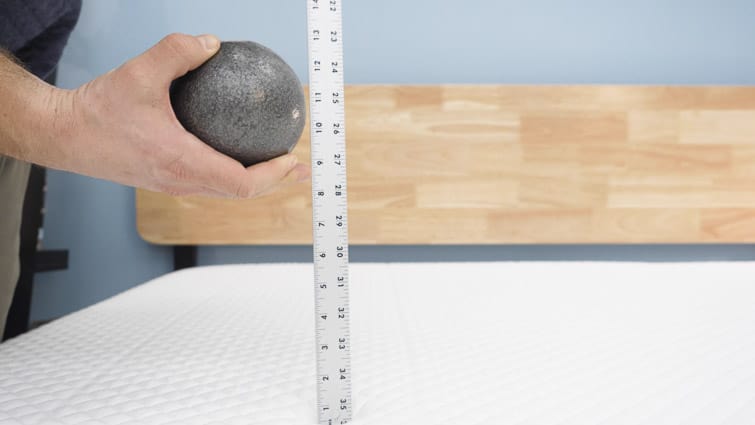
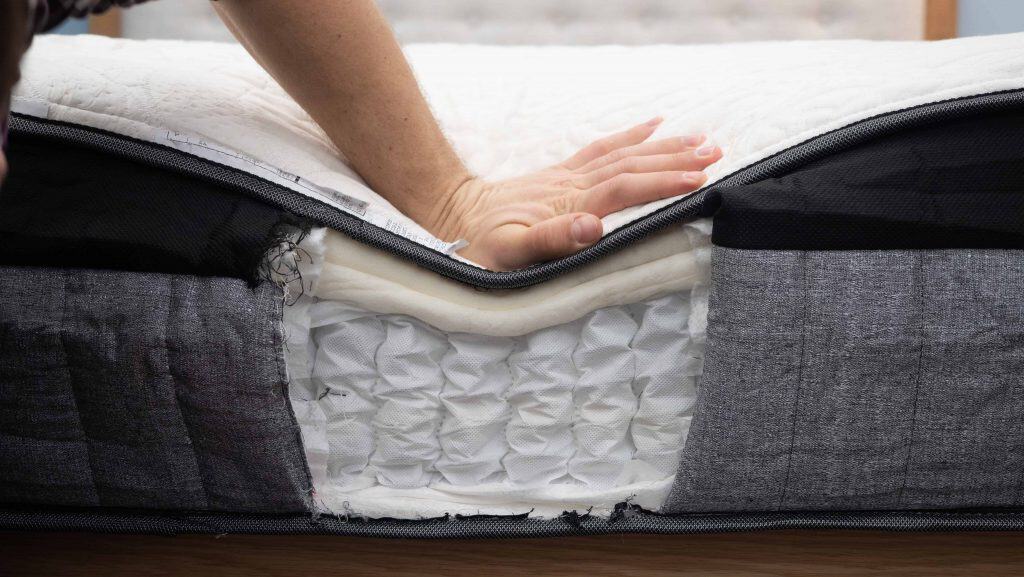
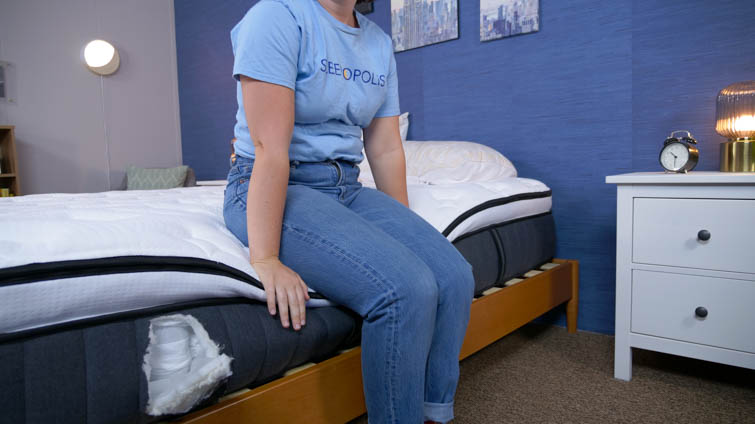
How We Chose These Mattresses
When handpicking the best mattresses for side sleepers this roundup, we first and foremost considered the pressure relief results and materials scores in our Sleepopolis mattress lab. Because side sleepers put the most pressure on their shoulders and hips, we wanted to make sure the mattress’ pressure map results showed adequate pressure relief. None of the products included here are likely to put added pressure on these areas.
Additionally, we wanted to ensure that these mattresses have quality foams and materials to provide not just quality pressure relief, but long-lasting pressure relief. When testing each bed, we found that all 10 of these mattresses scored at least a 4 in materials.
FAQs
What kind of mattress should a side sleeper have?
Side sleepers usually fare well on a softer foam mattress that can contour their shoulders and hips.
What mattress firmness is best for side sleepers?
We recommend that side sleepers seek out a soft to medium-firm mattress in order to get the optimal blend of pressure relief and support.
What is the best mattress for side sleepers with shoulder pain?
From this roundup, we think that the Nolah Evolution is a good choice for side sleepers with shoulder pain. We also suggest taking a look at Saatva’s luxurious foam mattress, the Loom & Leaf.
What is the best mattress for side sleepers with back pain?
We think the Bear Star Hybrid is the best mattress for side sleepers with back pain. Scroll up to our mini review to learn more.
Are hybrid mattresses better for side sleepers?
Hybrid mattresses are not necessarily better for side sleepers than other mattresses, but there are a number of people who would benefit from the qualities of a hybrid. Heavier side sleepers, or side sleepers wanting added support, durability, and sometimes firmness, can find what they’re looking for in many hybrid beds on the market. It genuinely comes down to the feel you’re looking to achieve. For example, side sleepers wanting lots and lots of sinkage and contouring might fare better on a memory foam mattress with a plush comfort layer and a dense foam support layer.
Best Mattresses for Side Sleepers 2024
| Mattress | Best For | Price (Queen Size) | Coupon | Review |
| Helix Midnight | Overall | $1,374 | Helix Coupon | Read Review |
| Saatva | Combination Side Sleepers | $1,995 | Saatva Coupon | Read Review |
| Nectar | Memory Foam | $1,043 | Nectar Coupon | Read Review |
| WinkBeds | Cooling | $1,799 | WinkBed Coupon | Read Review |
| Brooklyn Bedding Aurora Luxe | Hip Pain | $1,874 | Brooklyn Bedding Coupon | Read Review |
| Titan Plus Luxe | Heavy People | $1,599 | Titan Coupon | Read Review |
| Bear Star Hybrid | Back Pain | $1,732 | Bear Coupon | Read Review |
| Nolah Evolution | Soft | $2,299 | Nolah Coupon | Read Review |
Sources
Leilnahari, Karim, et al. “Spine Alignment in Men during Lateral Sleep Position: Experimental Study and Modeling.” BioMedical Engineering OnLine, vol. 10, no. 1, 30 Nov. 2011, p. 103., doi:10.1186/1475-925x-10-103.
Herrington, Lee. “Assessment of the Degree of Pelvic Tilt within a Normal Asymptomatic Population.” Manual Therapy, vol. 16, no. 6, 11 June 2011, pp. 646–648., doi:10.1016/j.math.2011.04.006.
Gordon, Susan, et al. “A Randomized, Comparative Trial: Does Pillow Type Alter Cervico-Thoracic Spinal Posture When Side Lying?” Journal of Multidisciplinary Healthcare, 17 Aug. 2011, p. 321., doi:10.2147/jmdh.s23028.
Poorbaugh, Dr. Kenneth. Personal interview.
Clinical trials: CELLIANT. https://celliant.com/clinical-trials/

